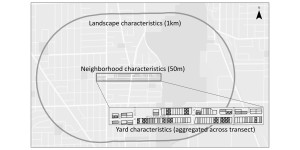Spatial analysis methods for understanding environmental characteristics in the urban “matrix”
Residential yards comprise a substantial portion of urban landscapes, and the collective effects of the management of many individual yards may ‘‘scale up’’ to affect urban biodiversity. In this paper, the authors studied the relative importance of environmental variables at multiple spatial scales for native bird diversity in Chicago, Illinois. Specifically, they analyzed environmental variables at the yard scale, the neighborhood scale, and the broader landscape scale.
For yard-scale analysis, the authors linked information from a social survey to individual address locations to calculate environmental variables such as the percent of yards with bird feeders or with insecticide use. For neighborhood-scale analysis, the authors created a 50m buffer around each study site and then used GIS data layers from two sources (QuickBird satellite imagery and LiDAR) to calculate the percent vegetation cover and percent canopy cover within each buffer. For the broader landscape-scale analysis, the authors created a 1km buffer around each study site. They used GIS data layers from three sources (LiDAR, Esri, and CMAP) to calculate the values of three landscape-scale environmental variables, including percent canopy cover within 1km, amount of open space within 1km, and distance of each study site to the nearest river.
The authors conducted a model selection analysis to determine the relative importance of environmental variables at each spatial scale for native bird species. They found that the environmental characteristics at the yard scale were the best predictors of native bird species richness, which suggests that the collective effects of individual yard design and management decisions are very important for urban bird biodiversity.
“Having our yards and sharing them too: the collective effects of yards on native bird species in an urban landscape.” Ecological Applications 24(8):2132-2143. J.Amy Belaire, Christopher Whelan, and Emily Minor. 2014.
